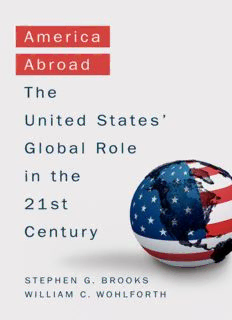
America Abroad: The United States’ Global Role in the 21st Century PDF
Preview America Abroad: The United States’ Global Role in the 21st Century
i America Abroad ii iii America Abroad The United States’ Global Role in the 21st Century z STEPHEN G. BROOKS WILLIAM C. WOHLFORTH 1 iv 1 Oxford University Press is a department of the University of Oxford. It furthers the University’s objective of excellence in research, scholarship, and education by publishing worldwide. Oxford is a registered trade mark of Oxford University Press in the UK and certain other countries. Published in the United States of America by Oxford University Press 198 Madison Avenue, New York, NY 10016, United States of America. © Oxford University Press 2016 All rights reserved. No part of this publication may be reproduced, stored in a retrieval system, or transmitted, in any form or by any means, without the prior permission in writing of Oxford University Press, or as expressly permitted by law, by license, or under terms agreed with the appropriate reproduction rights organization. Inquiries concerning reproduction outside the scope of the above should be sent to the Rights Department, Oxford University Press, at the address above. You must not circulate this work in any other form and you must impose this same condition on any acquirer. CIP data is on file at the Library of Congress ISBN 978– 0– 19– 046425– 7 1 3 5 7 9 8 6 4 2 Printed by Sheridan Books, Inc., United States of America v To Avery Brooks, Charlie Wohlforth, and Owen Wohlforth. vi vii Contents Preface ix Acknowledgments xi 1. Introduction 1 2. Assessing America’s Global Position 14 3. Assessing Change in a One- Superpower World 48 4. America’s Grand Strategic Choice 73 5. The Security Logic of Deep Engagement 88 6. Assessing the Security Benefits of Deep Engagement 103 7. Assessing the Economic Cost of Deep Engagement 122 8. Assessing the Security Costs of Deep Engagement 134 9. The Economic and Institutional Logic of Deep Engagement 155 10. Assessing the Economic Benefits of Deep Engagement 171 11. Conclusion 190 Notes 201 Index 259 viii ix Preface When we finished our last book on America’s role in the world in 2007, we hardly thought we would write another on the same general subject. In World Out of Balance we probed the main scholarly traditions in interna- tional relations for insights about how the world works when one state dra- matically outweighs all others on the scales of power. But almost as soon as it hit the shelves, its underlying premise, that the United States would long occupy a singular position at the top of the international system— until then almost universally taken for granted— came under strong challenge. In his 2002 Financial Times article, historian Paul Kennedy— by far the world’s most widely read expert on the rise and fall of great powers— stated flatly, “Nothing has ever existed like this disparity of power; nothing.” By 2010 he was reasserting for readers of the New Republic his more familiar theme, that the United States, overburdened and confronting fast rising rivals, was “nat- urally losing its abnormal status in the international system and returning to being one of the most prominent players in the small club of great powers.” Had the world really shifted so fast as to warrant this new focus on a coming “post- American” world? To answer that question, we would need to do something we had not done in our previous book: carefully measure how the distribution of power was changing and do so in a way that was sensitive to the changing nature of power in the 21st century. The distribution of ca- pabilities among states is a moving target— it never stands still— and the first part of this book represents a years- long effort on our part to comprehend the changes afoot and project their likely trajectory. Our answer is revealed in chapters 2 and 3, which show that, although the world is changing, America’s role within it is not shifting nearly as much or as quickly as is commonly believed. It was not just perceptions of power that shifted quickly. The scholarly conventional wisdom about what the United States should do with its power also underwent a sea change. What had been a handful of scholars calling
Description: